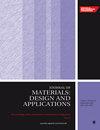Dissimilar welding between Cu–6Al–2Ni alloy and stainless steel 316L using continuous ytterbium YAG laser
IF 2.2
4区 材料科学
Q3 MATERIALS SCIENCE, MULTIDISCIPLINARY
Proceedings of the Institution of Mechanical Engineers, Part L: Journal of Materials: Design and Applications
Pub Date : 2024-04-09
DOI:10.1177/14644207241245264
引用次数: 0
Abstract
The Cu–6Al–2Ni alloy has much higher ultimate tensile strength compared to pure copper and may potentially replace it in the dissimilar joints between titanium alloys and stainless steels. Laser welding of aluminum bronze to stainless steel has not been reported in the scientific literature, which motivated the present weldability study of Cu–6Al–2Ni/316L dissimilar joint with a continuous ytterbium Yb:YAG laser. Different laser spot offsets from the joint line were selected in order to produce the joints with various dilutions of welded materials. Scanning electron microscopy with energy-dispersive X-ray spectroscopy (SEM-EDS) probe and X-ray diffraction (XRD) analyses of the melted zones were performed, along with microhardness measurements and tensile testing. The phase evolution in the obtained microstructures was evaluated using Thermo-Calc software. For the dilutions ranging from 23 to 63 at.% Cu, the melted zones showed globular microstructures with primary and secondary phase separation due to the miscibility gap existing in the Cu–Fe system. Lower Cu contents resulted in cellular γ-Fe structures with rare globular Cu-rich inclusions. The XRD analysis indicated the presence of ∼10% of ternary AlFe使用连续 YAG 镱激光器在 Cu-6Al-2Ni 合金和 316L 不锈钢之间进行异种焊接
与纯铜相比,Cu-6Al-2Ni 合金具有更高的极限抗拉强度,有可能取代纯铜用于钛合金和不锈钢之间的异种接头。铝青铜与不锈钢的激光焊接在科学文献中尚未见报道,因此本研究采用连续镱Yb:YAG 激光器对Cu-6Al-2Ni/316L 异种接头进行了可焊性研究。为了用不同稀释度的焊接材料制作接头,选择了不同的激光光斑偏离接头线的位置。对熔化区进行了扫描电子显微镜与能量色散 X 射线光谱(SEM-EDS)探测和 X 射线衍射(XRD)分析,以及显微硬度测量和拉伸测试。使用 Thermo-Calc 软件对所获得的微结构中的相演变进行了评估。在铜含量为 23% 至 63% 的稀释液中,熔化区呈现出球状微观结构,由于铜-铁体系中存在混溶间隙,因此存在主相和次相分离现象。较低的铜含量会产生蜂窝状的 γ-Fe 结构,并伴有罕见的球状富铜夹杂物。XRD 分析表明存在 ∼10% 的三元 AlFe2Ni 相,但这并不影响焊缝的机械性能。根据 Thermo-Calc,该相是在冷却过程中由γ-Fe 形成的。显微硬度测量结果表明,熔化区没有发生脆化,这可以用 AlFe2Ni 的亚微粒分散来解释。在广泛的激光偏移范围内,Cu-6Al-2Ni 焊缝的极限抗拉强度为 350-420 兆帕,表现出延展性断裂,远高于之前报道的纯铜/316L 接头的结果。
本文章由计算机程序翻译,如有差异,请以英文原文为准。
求助全文
约1分钟内获得全文
求助全文
来源期刊

CiteScore
4.70
自引率
8.30%
发文量
166
审稿时长
3 months
期刊介绍:
The Journal of Materials: Design and Applications covers the usage and design of materials for application in an engineering context. The materials covered include metals, ceramics, and composites, as well as engineering polymers.
"The Journal of Materials Design and Applications is dedicated to publishing papers of the highest quality, in a timely fashion, covering a variety of important areas in materials technology. The Journal''s publishers have a wealth of publishing expertise and ensure that authors are given exemplary service. Every attention is given to publishing the papers as quickly as possible. The Journal has an excellent international reputation, with a corresponding international Editorial Board from a large number of different materials areas and disciplines advising the Editor." Professor Bill Banks - University of Strathclyde, UK
This journal is a member of the Committee on Publication Ethics (COPE).
 求助内容:
求助内容: 应助结果提醒方式:
应助结果提醒方式:


